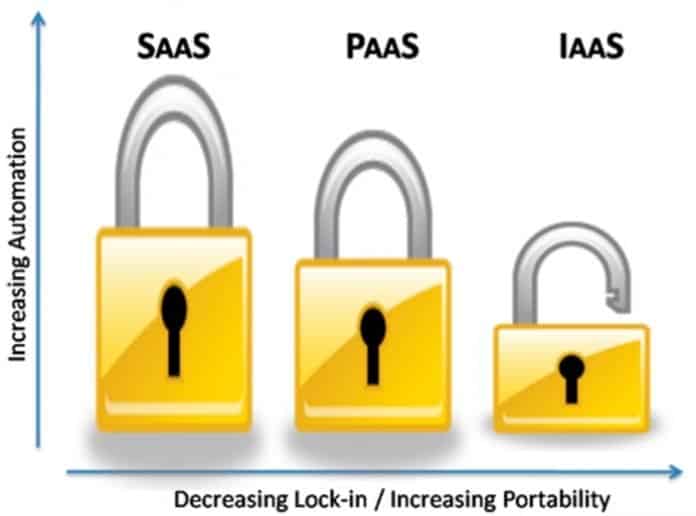Vendor Lock-in Cloud Computing is a critical issue for cloud computing. This vendor lock-in is a secret strategy for cloud hosting service providers. However, it is malpractice of business ethics. The customer is king, but vendor lock-in makes them prisoner. Vendors are intelligent enough to hold the customer differently. This vendor lock-in strategy is one of them.
What is Vendor Lock-in
The term vendor lock-in comes from economics. It is popularly known as the proprietary lock-in or customer lock-in. The main purpose of this lock-in is to make dependent the customers to the vendors. The customer cannot switch over to another vendor if the vendor lock-in exists.
However, the customer can expend a huge amount of money to switch over or prepare a new vendor with high investment costs. Basically, this is a strategy of monopoly business. This type of funny business happens normally in the IT arena. There is a case study regarding Microsoft and its strategy. The article “Criticism of Microsoft” will clear you.
Vendor lock-in Cloud
A vendor lock-in cloud is a situation of cloud computing where the customer or consumer is bound to follow the program of cloud computing service providers. Basically, this is a game of data. When the organization keeps the backup of all data to a cloud server, and there is no other alternative cloud storage, the customer is locked.

The customer cannot switch over to another vendor because of the agreement. As a result, the user has to go with an existing cloud service provider. Otherwise, they have to contract with another new cloud service provider with a high initial cost.
Causes of Vendor Lock-in Cloud Computing
- Vendor lock-in is malpractice and an example of a bad attitude. The cloud service provider makes a lock-in for fear of losing the customer. They thought if the customer can shift any time, they can switch over to anywhere.
- There is a competition for cloud computing servers all over the world. Each of the cloud service providers offering several pricing models. As a result, the minor cloud service providers have the intention to hold the existing customers.
- The ethics of business varies from organization to organization. If the cloud service providers practice lock-in their customers, then they follow vendor lock-in strategy.
Fears of Cloud Vendors lock-in
Actually, there is less than 10% of world businesses use cloud computing. The newer are afraid of going to cloud implementation. Moreover, the buzzword of vendor lock-in hit the mind of the possible cloud customer. Really they are afraid of it. As a result, some problems arise, which are:
1. SLA of Cloud Computing
Control of dataThe main question of cloud computing is who will control the data. If the SLA mention using authority, then no problem. But the fear arises if it is not mentioned in the Service Level Agreement (SLA).
2. Dependence on a Single Vendor
There are so many critical needs in cloud computing, for example, server, networking type, user management, data backup, and many other issues. So the customer doesn’t know where he may lock in. That’s fear.
3. Meet the Future Needs of Cloud Computing
There is a fear of meeting future needs. Your current cloud service provider may not fulfill your future needs. As a result, you have to rethink the cloud service provider.
4. Going Out of Business or have a Possibility
If your cloud partner goes out of business or changes their technology, it will create a great problem. So you have to consider the future planning of the present cloud service provider.
5. Switching Cost of Cloud Computing
The climax arises at the time of switching the cloud service provider. The question is regarding the export data. With this support to the next vendor? Definitely, it is a gray area. Despite solving all those problems, there may be a high switching cost.
10 Tips to Avoid Vendor Lock-in
There a lot of ways to avoid Vendor Lock-in. The first of all is consciousness. The other ways to avoid Vendor Lock-in are:
1. Prepare Service Level Organization
Service level organization is the constitution of any organization. At the time of agreement of cloud computing, both the party study the SLA well. There should be mentioned specifically regarding the data ownership, data management, data backup, and control authority of data.
2. Use Open Source Technologies
If it is possible to use open source technologies, then use open source technologies. There are many reasons to use open source technologies. First of all, it is free. Second one no tension to control of data ownership. Any time you can change. Finally, open-source technologies are always good. Have fun with open-source technologies.
3. Use Universal Platform
All the vendors do not use the same infrastructure. As a result, it arises some problems with data migration. So it is wise to follow the universal cloud infrastructure to have the same hierarchy of databases. This will offer the cloud service user more flexibility.
4. Analyze the Other Cloud Service Provider
Obviously, many cloud service providers offer more flexibility to their customers. As an IT manager, you have to study those companies. However, you can study Microsoft Azure, Timereaction, AWS, and Google cloud platforms.
5. Be Deliberate of Vendor Lock-in
The organization goes for cloud computing to solve the existing problem. But if the cloud supplies more problems than existing, then they will not use cloud computing. So there is a certain policy to avoid the vendor lock-in problem. Be frank, honest about your speech. Share your liking and disliking to your cloud service providers. Finally, it will help to avoid vendor cloud lock-in.
6. Follow The Cloud Data Management Interface (CDMI)
The Cloud Data Management Interface (CDMI) defines the cloud strategy, policy, dos, and don’ts. This is under the Storage Networking Industry Association. It started its journey in 2009. Cloud Data Management Interface defines RESTful HTTP operations.
It helps implement access control, attaching metadata, making arbitrary queries, using persistent queues, managing users and groups, specifying retention intervals and holds for compliance purposes, using a logging facility, and billing.
7. Use Multi-Cloud Computing
Multi-cloud computing is using more than one cloud computing service provider to avoid vendor lock-in. This is the distribution of cloud software among different cloud storage. It reduces the user’s tension. Multi-cloud is the combination of private cloud, public cloud, and hybrid cloud. IaaS, PaaS, and SaaS can be integrated into multi-cloud.
8. Take the Service of Separate Supplier
In cloud computing, the organization needs many additional INS services. There are options to take from the same cloud service providers or separate suppliers. To take separate technical services, the company should have expert IT professionals. However, the final thought is to use separate cloud service providers to avoid cloud vendor lock-in.
9. Retain Ownership of Your Data
Data is the main asset of your organization. So it would help if you took ownership of your data. The ownership includes source code. The organization uses SaaS, Pass, and IaaS. Intellectual property is another consideration of cloud data. You must be well aware of this regard.
10. Get the Second Opinion of Cloud Computing
The second opinion means an opinion from the expert. As a big organization, you must have some expert adviser. You may take several examples from your peers. Competitor’s analysis is another great aspect. You may hire a professional to make a wise decision to avoid cloud vendor lock-in.
Final Thought
Vendor Lock-in Cloud Computing is a strategy of cloud service providers. Many cloud service providers have the intention of Vendor Lock-in Cloud Computing. It increases revenue but damage ethics. So, it is not a new thing for the cloud world. It would help if you studied more to avoid Vendor Lock-in Cloud Computing.





